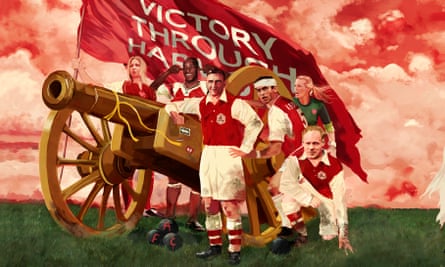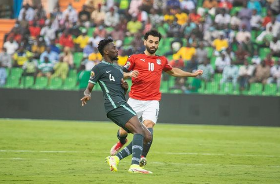Arsenal revamp captures buzz around a club that finally feels vibrant again | Arsenal
In an exhibition space half an hour’s walk from the Emirates, figures from Arsenal’s past and present were given a glimpse of the club’s new face. Their home’s exterior will soon be adorned with eight fresh pieces of artwork created in collaboration with supporters, replacing the images that had greeted visitors for more than a decade, and scaled-down versions of the installations were put on show.
Everyone may fancy themselves as an art critic but there was a hum of appreciation as Charlie George, Kenny Sansom, George Graham, Bob Wilson, David Seaman, Ian Wright, Jack Wilshere, Vic Akers, Anita Asante and Rachel Yankey took in depictions of the legacies each had left.
Also present were some of those who make the modern machine tick. Arriving early, Martin Ødegaard could be seen working the room: it was no five-minute obligation for the Premier League leaders’ captain, who was generous and genuine with his time. There were fans in the room and nobody felt left out. A simple but not infrequent observation was that certain among Arsenal’s recent captains would not have made the effort.
Ødegaard’s ease and the occasion itself felt emblematic. Arsenal retreated into their shell as the lustre wore off their achievements of the early 2000s and for all the success of their promoting the brand internationally elements of the messaging felt forced. They were not offering enough closer to home in the meantime but that has changed. While the turnaround needs backing up with sustained success Arsenal feel vibrant, relevant, outward-facing and more comfortable with their identity than at any time in the past decade and a half.
That applies on the pitch and off it. Arsenal visit Tottenham on Sundayand while they are yet to win at their rivals’ new home, only one of the teams really know who they are. It was striking to hear Mikel Arteta asked how he expected Spurs to set up and admitting he could not be sure. “Sometimes they approach games in different ways. Sometimes they are very aggressive from the beginning and sometimes they allow you to make the game.”
The element of surprise can, and may yet, be advantageous. But the point is that everyone knows what Arsenal will bring. The patterns of play are clear; so is the fact they will start like a train. Increasingly allied to those things is the sense they will find a way through. Eight months ago, Arsenal lost this fixture 3-0 and left feeling aggrieved with themselves and the officials. What is the difference now? “We win more games,” Arteta said, allowing himself a grin. “That is the thing that changes everything and I think we play better.”

He thinks correctly. Arsenal are sleek, dominant, increasingly savvy and it does their image no harm that there is no younger squad in the top flight. Only bottom-placed Southampton, with an average age of 24.3 to Arsenal’s 24.1, come especially close. Ødegaard, the designated on-pitch leader, turned 24 in December. It is a side that can speak to younger people: whether the erudite, friendly Ødegaard is doing the talking, whether the conversation buzzes through London’s five-a-side pitches thanks to an academy product such as Bukayo Saka, or whether a young Brazilian in Gabriel Martinelli is blazing a trail for hopefuls more than 5,000 miles away.
Capturing that freshness was among the reasons for Arsenal’s revamp of the Emirates, which will begin this month. The previous mural, which no arriving supporter could miss, depicted 32 former players locked in a huddle around the venue. It looked protective, close, smelled of togetherness, and each figure had his back turned to the outside world. But the ground no longer feels a quiet, reflective, insular place: since the Covid-19 lockdowns ended it has felt loud, raucous, often genuinely hostile to opponents, spurred on in part by a youthful element named the Ashburton Army who congregate in black behind the Clock End. Where once there were protests at the club’s role in the Super League cabal, Arsenal are making a positive noise.
That was supposed to be the case for Tottenham when they finally played at their new home in April 2019. It would be over-egging things dramatically to say Spurs have failed in comparison since that move: they are the Champions League whereas Arsenal are not, and are perfectly capable of winning the derby again.
Their fans have little trouble generating volume of their own. There has been no away win in a league game between these clubs since Arsenal prevailed at the old White Hart Lane nine years ago. “The atmosphere has an input and affects the game in a way,” Arteta sad of that curiosity. “I’ve been through a few of them, trying to understand why that happens, in the last few days. It’s difficult to get some conclusions but the atmosphere, it’s important.”
But the feeling is that Tottenham, with the division’s joint third-oldest set of players and no obvious succession plan for Harry Kane and Son Heung-min who have done so much to earn supremacy in north London, lack Arsenal’s clear identity. Just as the Emirates had come to feel as tired as a lumbering team when set alongside the gleaming new venue along Seven Sisters Road, there is a timeliness to the fact Arsenal are sprucing up their own environment in this sweet spot of ascendancy.

There is no sign of Ødegaard or anyone else in the current Arsenal side on the new artwork. A strong argument was made for the involvement of Saka, to take one example, but there is never any guarantee of how an active player might be regarded in the future. Plenty can go wrong. So much is going to plan at the moment and the challenge for this vintage is to secure their place on the ground’s next layer of skin.
“The players are in a good emotional state,” Arteta said. It felt that way watching Ødegaard exchange tales with those who have walked before him and dwelling on the thoughts of supporters who have become accustomed to seeing him hold games in the palm of his hand.
Breaking the pattern of home victories on Sunday would be further evidence that, for Arsenal, the picture has changed completely.





